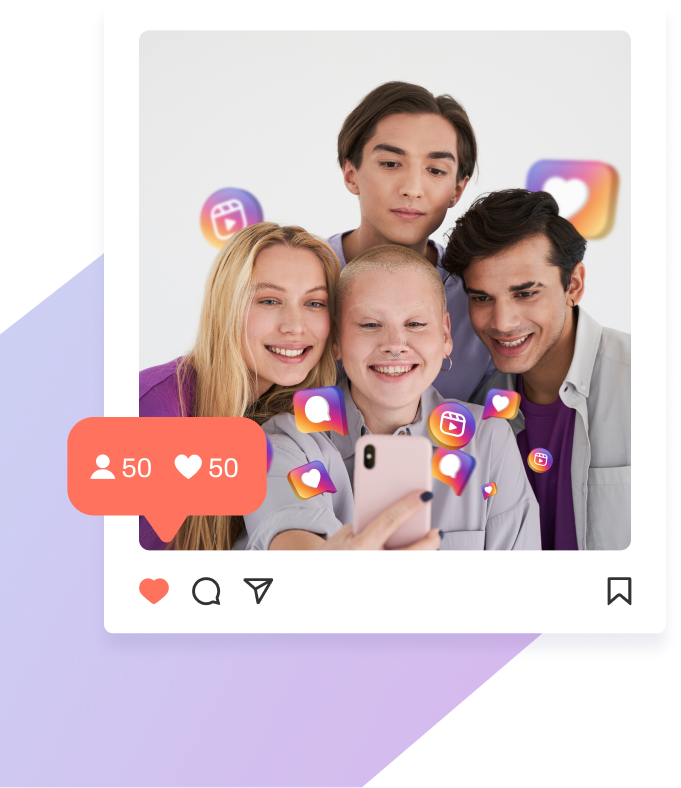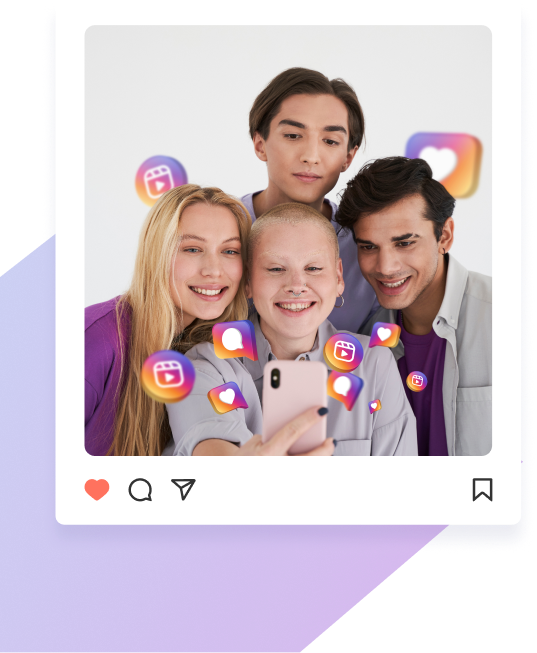Social Media Apps for Teens – What’s Trending?
Teens love spending time online. The screen glues them, and why wouldn’t it? Social media apps for teens are so addictive they can hook anyone. More than 95% of teenagers have access to smartphones these days.
The new generation’s approach to social media platforms is markedly different from previous generations. These platforms are no longer just about connecting with friends. They have become spaces for self-expression, learning, and even career development.
The shift from desktop-based platforms to mobile-centric apps reflects a broader change in how teens consume and create content. They prefer platforms that offer instant connectivity, interactive features, and a chance to showcase their creativity.
However, this digital landscape is not without its challenges. Issues such as privacy concerns, inappropriate content, and the psychological impact of these apps are concerning.

What Is the Most Popular Social Media App for Teens?
What is the most popular social media app for teens? As we delve into the topic, it’s important to understand the nuances of each. These platforms shape their social interactions, influence their views, and even affect their mental health.
By exploring these trends, we gain insight into the digital world for teens and how it’s shaping their lives.
YouTube
YouTube stands as a titan in the teen digital world. Its journey from a video-sharing site to a cultural phenomenon speaks for its adaptability. Teens flock to YouTube for various reasons, including entertainment, education, DIY tutorials, etc. They also follow the lives of their favorite influencers via YouTube. YouTube allows them to explore diverse interests – from music to science – in a visually engaging way.
However, YouTube’s challenges are as prominent as its successes. The platform has faced criticism for its algorithm promoting inappropriate content to younger audiences. Additionally, the prevalence of ads sometimes detracts from the user experience.
But YouTube’s ability to constantly reinvent itself keeps it relevant and popular among teens. It’s a space where they can watch and create content that resonates with their interests.
Snapchat
Snapchat revolutionizes how teens communicate, emphasizing spontaneity and authenticity. Its signature feature (messages that disappear) appeals to teens seeking more private and casual interactions. Moreover, Snapchat’s filters and lenses add fun to daily communications, allowing teens to express themselves creatively.
However, Snapchat’s disappearing messages feature also raises concerns. The volatile messages can encourage questionable behavior due to a lack of activity history. Furthermore, the platform’s focus on visual aesthetics has implications for teen self-esteem and body image.
Despite these challenges, Snapchat remains a staple in teen social media routines. Its ability to constantly innovate, introducing new features like Snap Map and augmented reality experiences, makes it appealing to teens.
Transitioning from Snapchat’s momentary nature, Instagram offers teens a more permanent canvas for their digital expressions. This platform has become a cornerstone of teen social media use on mobile devices. It allows them to share photos and videos with a broader audience.
Using Snapchat’s temporary posting concept, Instagram Stories provides a blend of permanence and impulsiveness. Teens use Instagram to showcase their lives and creativity and connect with friends through visually appealing content.
However, Instagram’s impact on teen self-image and mental health is a growing concern. The thirst for more likes and followers on Instagram is never-ending. On the other hand, the portrayal of an idealized life can create immense pressure.
Instagram’s continuous introduction of new features, like IGTV and Reels, keeps teens hooked.
While Instagram offers visually stunning content, WhatsApp changes the game in text-based communication. This app has become a staple in teen communication, offering a secure and versatile messaging experience. It’s a platform where they connect with people conveniently.
Teens use WhatsApp for its simplicity and security in sending texts, sharing multimedia, and even making voice and video calls. Group chats on WhatsApp are particularly popular, allowing teens to stay connected with friends and family.
Privacy is a key feature of this application, with end-to-end encryption safeguarding conversations. However, the app’s requirement for all parties to be users can limit its reach.
Despite this, WhatsApp’s global popularity is irrefutable. It’s a platform that supports casual chats and facilitates group studies, project collaborations, and much more. It exemplifies how communication apps have evolved to meet the multiple needs of today’s teens.
Kik
Moving from WhatsApp’s structured communication, Kik offers a different experience with its focus on anonymity. Teens appreciate Kik for its privacy, as it doesn’t require a phone number, only a username.
This feature makes it popular for chatting with new people and joining interest-based groups. Kik’s chat rooms cover various topics, providing a platform for teens to explore diverse interests and socialize openly.
However, Kik’s anonymity also brings challenges, particularly in moderating content and ensuring user safety. The platform has faced criticism for being a potential space for inappropriate interactions.
But Kik remains popular among teens who value privacy and the freedom to express themselves without revealing their identities. It represents the trend of anonymous social media, where teens can explore and interact without the constraints of real-world identities.
Telegram
In contrast to Kik’s focus on anonymity, Telegram emphasizes security and advanced functionality. This app appeals to tech-savvy teens with its encrypted messaging, large file transfers, and self-destructing messages.
Telegram’s cloud-based nature ensures messages sync across devices, providing a seamless user experience. Teens use Telegram for its reliable messaging, group chats, and unique features like bots and channels.
While Telegram’s advanced features are a draw, they can also be a barrier for less tech-savvy users. Setting up and navigating the app can be challenging for some.
Still, Telegram has carved out a niche among teens who prioritize privacy and seek a more sophisticated messaging platform. We can see how social media apps are diversifying to cater to different preferences and needs within the teen demographic.
X
X, formerly known as Twitter, offers teens a platform for real-time information and engagement. It’s a space where they can follow current events, interact with public figures, and express opinions.
Twitter’s appeal lies in its immediacy and briefness, making it a go-to source for news and trending topics. Teens use it to stay informed and participate in broader conversations.
However, Twitter’s character limit sometimes restricts deeper discussions. Moreover, the platform can get overwhelming due to the rapid flow of information.
Twitter is popular among teens who value up-to-date information and quick interactions. It demonstrates the shift towards fast-paced, bite-sized content consumption among the younger generation.
Tumblr
In contrast to Twitter’s fast-paced environment, Tumblr provides a more relaxed space for self-expression. This platform is popular among teens for its eclectic mix of content, including text, images, GIFs, and videos.
Tumblr allows users to create and customize their blogs, fostering a sense of individuality and creativity. It’s a haven for artistic expression, fandoms, and niche interests.
However, Tumblr has faced issues with explicit material and content moderation. These challenges have put it at odds with its young user base.
Tumblr’s flexible format and supportive communities make it a favorite for teens who seek a personal and creative outlet. It also represents the diverse ways in which social media can cater to different aspects of teen identity and interests.
TikTok
Be it Hispanic teens or affluent teens, everyone is a fan of TikTok. The app continues to dominate as teens’ preferred social media platform in 2023. Although its favorability slightly dipped, it still commands a 37% share. This dominance highlights TikTok’s unique blend of creativity and engagement, which connects deeply with the teen audience.
Even though there were data privacy concerns and federal scrutiny, TikTok still maintained its position as the top platform. Maybe the consistent marketer support is the reason behind its success.

Most Dominant Social Media Apps
Snapchat and Instagram maintain their positions as the most favored apps among teens.
Snapchat’s appeal comes from its momentary messaging and creative visuals, while Instagram captivates with its rich visual storytelling. Both platforms – despite facing challenges – have successfully adapted to remain relevant in the social media world.
Snapchat regularly introduces new updates to stay relevant. On the other hand, Instagram is also climbing the ladder. The introduction of Reels demonstrates its commitment to evolving with teen preferences.
The sustained popularity of Snapchat and Instagram underscores their significance in the social media world. They are not merely platforms that connect but provide teens with options to express themselves creatively.

How Does Social Media Affect Teenagers?
Are you wondering how social media affects teenagers? Social media profoundly affects teenagers, presenting both advantages and challenges. Platforms like TikTok, Instagram, and Snapchat have become central to teen life, offering spaces for creativity, learning, and connection.
- Sharing Lives Online
Teens use these platforms to share experiences, express themselves, and build communities. They connect globally, broadening their horizons and fostering belonging. However, these benefits come with significant drawbacks.
- Pursuit of Attention
Pursuing attention and acknowledgment on social media often leads teens to engage in negative behaviors. They find themselves comparing their lives and appearances to others, leading to low self-esteem. This quest for online validation can overshadow genuine self-expression.
- Cyberbullying
Cyberbullying and online harassment are also prevalent on social media, impacting teens’ mental well-being. Prolonged exposure to negative interactions can lead to anxiety, depression, and a distorted self-image. Excessive social media use also disrupts sleep patterns, contributing to sleep deprivation and exacerbating mental health issues.
Parents play a crucial role in guiding teens through the digital landscape. They must understand social media’s impact and have open conversations about online safety and responsible use.
Encouraging a balance between online and offline activities can help mitigate social media’s negative effects. Parents can also aid in developing critical thinking skills for discerning online content.

Should Parents Monitor Their Children’s Social Media?
The internet is full of debates regarding one question, “Should Parents Monitor their Children’s Social Media?” The answer is yes. Most netizens believe that parents should know what teenagers are consuming online. But how?
Social Media Monitoring
For parents concerned about their children’s online well-being, social media monitoring is crucial. Various parental control tools are available to help keep tabs on teens’ digital activities. These tools empower parents to understand how their kids use their devices, including time spent on apps and online interactions.
Tools To Make Safe Social Media Apps for Teens
Key features of these monitoring tools include the ability to block social media apps during specific times, like study hours. This is particularly useful for managing social media addiction. These tools help parents limit user access and ensure their children can only access safe social media apps for teens.
Best Social Media Apps for Teens
The list of best social media apps for teens includes Instagram, Snapchat, and TikTok when it comes to creativity. On the other hand, when it comes to educating – Duolingo, Khan Academy, and Quizlet lead the race. They provide learning experiences in engaging, social formats, combining education with the perks of social media.
Monitoring Text Messages
Monitoring text messages on social media is another vital aspect. Parents can receive alerts for the use of offensive or suspicious language. This feature aids in preventing cyberbullying and ensuring teens’ safety online.
Controlling Screen Time
Controlling screen time is also essential. Parents can limit access to third-party apps and set screen time limits. Detailed reports on device and app usage help parents understand their child’s online habits. This enables them to take steps to curb potential addiction.
This way, parents can monitor and control the social media consumption of teenagers.

Grow on Instagram With Path Social
Social media apps for teens have become integral platforms for self-expression, communication, and community building. Everyone uses the application that suits them. Some prefer Instagram, others like Tumblr – they are independent with their choices. Each platform provides unique perks but has its drawbacks. If we talk about Instagram, users are ready to pay for followers on Instagram.
Are you one of them? Join hands with Path Social. We use a smart AI-targeting algorithm to help users stand out on Instagram. Our expert team will bring real, interested followers to your profile. We can also help you with outstanding e-commerce apps or other ways to boost your Instagram sales.
Join Path Social now and Start growing and gaining Instagram followers today.


Want Free Instagram
Followers?
Let our AI targeted organic growth work for you for free
Get Free Instagram Followers







